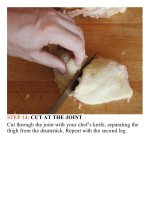The food lab better home cooking through science ( PDFDrive ) 462
Bạn đang xem bản rút gọn của tài liệu. Xem và tải ngay bản đầy đủ của tài liệu tại đây (154.55 KB, 2 trang )
the fish to a zipper-lock plastic bag, squeeze out as
muchairaspossible,andsealthebag.
Placeafrozenicepackinthebottomofabaking
dishandplacethebagwiththefishdirectlyontopof
it. Place a second ice pack on top of the fish. (You
canalsousezipper-lockbagsoficeinplaceoftheice
packs.)Storethefishforupto2days,replacingthe
icepacksastheythaw.
BoningFillets
More often than not, fish fillets you buy from the
supermarket or fish market still have a few bones
left in them.To remove them, you’ll need a pair of
sturdytweezers.**Gentlyrunyourfingersbackand
forthalongeachfilletuntilyoulocatetheendsofthe
bones.They’llfeellikefirmlittlebumpsintheflesh.
Useyourfingertiptopressthefleshrightaroundthe
end of the bone to expose it a little bit. Grasp the
exposed end of the bone firmly with the tip of the
tweezers.Holdyourfreehandflatagainstthefishas
near the bone site as possible and extract the bone
bypullingitinthedirectionit’spointing,tominimize
damage to the flesh. Discard the bone and repeat
untilthefishisclean.
SkinningFillets
I like to cook my fish skin on even if I’m going to
serve it skinless, as the skin helps insulate the fish
from the heat of the pan or oven, giving you more
evenly cooked flesh. But if you’d like to remove the









